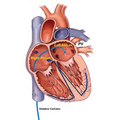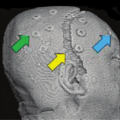DBP:Overview
Driving Biological Projects 2010-2013
The role of the driving biological projects (DBPs) is to motivate innovation by providing data and clear targets to drive algorithm and software development by the Computer Science Core. These projects must represent important practical problems that have a broad impact on health care delivery. The overall goal of NA-MIC, as it relates to the issue of personalized medicine, is to create integrated representations of the human body in health and disease that contribute to the overall understanding of each patient and each treatment decision. Medical image computing already has assumed a central role in the standard of care across a wide range of clinical indications. Yet, significant gaps remain between what is technically feasible versus what is practical. The current DBPs span a range of organ systems and medical specialties, including both degenerative and traumatic conditions. They bring substantial problems of a subject-specific nature that can be solved by improved image analysis. As a consequence, a strong core of general purpose technology will emerge from the union of the specific development paths of each of the DBPs.

|
Atrial Fibrillation The interventional cardiology application (CARMA) for the treatment of atrial fibrillation (AF), which is currently in development at the University of Utah, requires an integrated suite of software tools optimized for cardiac MRI. The purpose of these tools is to extract meaningful information to guide case management and treatment from customized acquisition sequences within the time constraints of an interventional procedure (i.e., 30 minutes). Using automated segmentation for precision guidance of interventional therapy based on the integration of pre-procedural and intra-procedural image data, these tools will enable targeted radiofrequency ablation of the portion of the diseased heart tissue that produces the arrhythmia. |

|
Huntington's Disease The multi-site PREDICT-HD consortium led by the University of Iowa on early detection of Huntington’s Disease (HD) uses multimodal image, genetic, and clinical data from a large population to formulate and test hypotheses about the evolution of chronic diseases in at-risk individuals. Early intervention with implantable drug delivery devices could revolutionize the treatment of HD, but there are attendant risks. The statistical models that result from the application of customized image analysis to the PREDICT-HD cohort will provide a basis for conducting clinical pharmaceutical trials with increased sensitivity both to improvements and adverse outcomes. |

|
Head and Neck Cancer The project in adaptive radiotherapy (RT) at Massachusetts General Hospital requires the quantification of change in body systems during disease progression and management to guide the application of radiation to tumor volumes while sparing critical structures. Segmentation and registration of serial CT datasets and interaction with commercial treatment planning systems will be used to determine best practices for radiotherapy, in general, with a particular benefit anticipated for proton therapy. |

|
Traumatic Brain Injury Current neuroimaging technologies are not able to detect neuroanatomical changes in individuals suffering from trauma or other pathology, because current methods rely on spatial normalization across subjects. However, longitudinal imaging allows patients to serve as their own controls and removes the need for inter-subject spatial alignment. This collaboration with UCLA to study traumatic brain injury (TBI) will take advantage of longitudinal imaging analysis by delivering customized analysis pipelines that are robust in the presence of the case-specific imaging signatures of head trauma. These pipelines promise to reveal previously hidden consequences of TBI to inform clinical decision-making. The breadth of the topics addressed by this portfolio of clinical research, together with the diverse set of applications targeted by the NA-MIC collaboration efforts described under Dissemination demonstrate the range of health care issues that can benefit from enhanced computer imaging systems. |